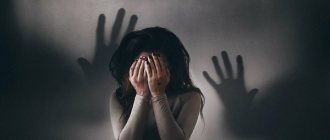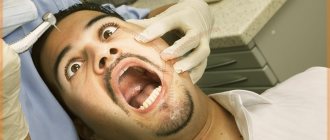04/23/2019 · Blog · No comments yet
Every person has experienced a panic attack (PA) at least once in their life - a sudden severe anxiety, which is accompanied by a racing heartbeat, increased blood pressure, and a feeling of heaviness in the chest. But not everyone who has experienced panic needs treatment. There is no treatment for panic attacks as such. Help is needed if PAs have become systematized, frequent, and the person cannot cope with the problem on his own. The article will focus on the so-called panic disorder.
Briefly about the problem
Panic disorder is spontaneous, unexpected panic attacks that occur at intervals from several times a year to several times a day and are characterized by the presence of anxious anticipation of the next panic attack.
Patients often have to consult various specialists to get the correct diagnosis. A person with panic disorder can be observed for a long time by a neurologist with a diagnosis of vegetative-vascular dystonia (VSD). Panic attacks and VSD are very similar. This is due to the fact that during panic the autonomic nervous system is actively working.
Symptoms during PA are associated with the activity of the autonomic nervous system: during severe anxiety, the hormone adrenaline enters the blood. This is necessary to trigger the biological survival program - the fight and flight reaction, which is genetically programmed. Adrenaline increases the heart rate, increases blood pressure, quickens breathing, blood rushes to the muscles of the arms and legs, flows out of the hands and feet, and the person breaks out in sweat. All this is needed to successfully implement the fight or flight response , nature’s stress response program.
The problem is that nowhere except Russia there is such a diagnosis - VSD. With VSD, the symptoms are vague, and there is no specific cause of the disorder. Therefore, the symptoms of panic disorder easily fit into the criteria for VSD; the person is given an incorrect diagnosis , and accordingly he does not receive proper adequate treatment.
If a person has been correctly diagnosed and has been referred to a psychotherapist or psychologist, then PA therapy for panic disorder can be effective and short-term, even without the use of medication.
How do panic attacks become panic disorder? Initially, there are two reasons for panic attacks: a strong negative or positive experience.
A person experienced stress or had a joyful event, and the body responded to this with physical symptoms. If a person does not attach importance to these symptoms and does not fixate on them, then everything is fine.
If a person fixates on the symptoms and begins to see in the changes occurring in the body an impending disaster - a heart attack, stroke, signs of loss of control and insanity, then this is the first step towards panic disorder .
The second step is to wait for a similar condition to recur, which already leads to the fact that a small amount of adrenaline enters the blood, a vegetative reaction is triggered, and so on in an increasing manner.
Another important criterion for panic disorder is protective behavior. This behavior manifests itself in a person’s actions in order to “save” himself from the consequences of panic symptoms - madness, heart attack, stroke. Protective behavior includes taking medications, calling a doctor, the need to lie down, sit down, and not be left alone.
Protective behavior is a disservice to yourself when dealing with panic disorder. A person has no way to make sure that nothing terrible will happen, that he will calm down over time, without resorting to any means.
This behavior is difficult to refuse. In the short term, it reduces anxiety, but in the long term, it increases it, since each time a person loses faith in his own strength in the fight against the disease.
In the absence of treatment, the repertoire of protective behavior expands, a person becomes more and more limited in life - withdrawal from social contacts, agoraphobia, a constantly high level of anxiety for health, visiting doctors in the somatic network, financial losses, and often the inability to work.
More about panic attacks
Panic attacks are a sharp increase in anxiety and fears that are generated by an internal state and are not related to the current situation. A typical form of panic fear is accompanied by various vegetative-vascular and motor manifestations, such as:
- pronounced feeling of anxiety;
- fear for your health and life;
- cardiopalmus;
- increased sweating;
- sudden changes in blood pressure;
- trembling in the body;
- lump in throat;
- feeling of lack of air;
- abdominal pain and gastric disorders.
Panic attacks very rarely (about 1%) are a sign of serious diseases, such as heart defects, pheochromocytoma, oncology, etc., in the vast majority of cases they are associated with the psycho-emotional sphere and the autonomic nervous system. It is through the autonomic nervous system that all the mechanisms of panic attacks are realized.
Photo on Unsplash
An atypical form of a panic attack, the so-called “panic without panic,” can be manifested by temporary loss of hearing, voice, vision (a veil before the eyes), a person’s sense of taste and smell disappears, and motor skills are turned off. Such symptoms are usually observed in serious procedural mental disorders.
Treatment of panic attacks
The standard treatment for panic disorder worldwide is cognitive behavioral therapy. It has proven its effectiveness in many domestic and foreign experimental studies.
Cognitive behavioral psychotherapy for panic attacks has a number of advantages:
- short-term (6-12 sessions);
- proven effectiveness;
- the ability to do without drug treatment.
Prescribing tranquilizers or antidepressants is advisable:
- the problem with panic has existed for a long time and the anxiety is so strong that starting psychotherapy is difficult;
- Panic disorder is accompanied by depressive feelings.
It should be emphasized that psychopharmacotherapy is only an auxiliary method of treating panic disorder. It does not solve the original problem, which will return after stopping the drugs.
Can a person cope with panic disorder on their own? Yes, with good motivation and good self-help manuals (there are very few of them in Russian).
The main difficulty in self-help remains the lack of a correct diagnosis.
The British NICE system of care for panic disorder places self-help in third place, after cognitive behavioral therapy and psychopharmacotherapy, which is prescribed only if the person has refused psychotherapy.
Stages of panic attacks
There are three stages of a panic attack:
- initial – warning signs of a panic attack appear. This may be some anxiety, uncertainty, heaviness in the head, inexplicable discomfort;
- expanded - a feeling of anxiety and fear appears, which steadily increases. It is at this stage that the main symptoms affecting the cardiovascular and respiratory systems occur. When anxiety and fear turn into panic, a person can no longer control himself;
- final - a feeling of lethargy, fatigue and weakness appears.
Foreplay can last up to half an hour, this time is quite enough to provide assistance and get rid of a panic attack. Panic, when a person is in a state of derealization, lasts on average about 30-40 minutes, maximum an hour. After a panic attack ends, it sometimes takes a day or more to fully recover and get rid of the consequences.
Photo by Max Nelson on Unsplash
Most often, panic attacks occur in the evening and at night, which can cause chronic insomnia, which in turn is a risk factor for the development of a panic state.
Benefits of PA psychotherapy
When turning to a psychotherapist in specialized clinics for the treatment of panic attacks, a person has the opportunity to significantly reduce the time of treatment for the disorder. The work follows specialized protocols that take into account all factors in the occurrence and maintenance of the disorder.
Who is psychotherapy suitable for?
Psychotherapy for panic disorder has no special contraindications . The restrictions relate to general contraindications in psychotherapy, for example, cognitive deficits in humans.
Therapy for panic disorder can be carried out without loss of effectiveness online via Skype. This is convenient for remote areas of Russia, where there are no specialists who successfully use methods of treating panic attacks and panic disorder.
How panic attacks are treated by a psychotherapist
The treatment protocol for panic disorder consists of:
- identifying panic triggers;
- psychoeducation of the patient - an explanation of the ongoing processes from a scientific point of view;
- identifying misconceptions about panic;
- withdrawal of protective behavior;
- exposition.
Exposure is the presentation of frightening situations, the experience of which gives the person a new experience that a panic attack is experienced. It helps reduce panic attacks during neurosis. This is a necessary element of therapy, which, through the experience of fear, under the supervision of a specialist, leads to a good result and recovery.
Signs of a panic attack
It's surprising that not everyone who suffers from panic attacks knows what it is. It often happens that a panic attack is mistaken for some kind of heart disease, because they have a number of similar symptoms.
A vegetative crisis (an alternative name for a panic attack) can begin with increased heart rate, chest pain, and a feeling of shortness of breath. Patients attempt to relieve symptoms with the help of heart medications, but in this case they will not have the expected effect.
Photo on Unsplash
Other signs of a crisis include trembling hands, dizziness, excessive sweating, chills, a feeling of unreality of what is happening, impending loss of consciousness, inexplicable uncontrollable fear. At the same time, the presence of fear is not at all necessary: at the moment of an attack there may not be a panic attack, but instead, sadness, tearfulness or aggression are felt.
The duration of a panic attack can vary. The average duration is from 15 minutes to half an hour. Frequency of attacks: from several episodes a day to a couple of times a month. In principle, this is not a dangerous phenomenon, but there is a risk that panic attacks can have a bad effect on the psychological state, which will only increase their number.
Clinical picture
The duration of attacks is from 15 minutes to several hours, the frequency is from 2-3 times during the day or once a month.
As a rule, panic attacks occur suddenly, against a background of complete calm. But most patients claim that attacks more often develop under stress, in a small enclosed space, or in crowded transport. At the first attacks, a person does not understand what is happening to him. If the patient is very frightened, he suspects the presence of severe cardiovascular pathology, endocrine or nervous disorders, and calls an ambulance.
After the first panic attack, a person makes an appointment with various specialists, undergoes an examination, and suspects the presence of a rare disease. The patient concentrates excessively on his health, which aggravates the course of the attacks.
As a rule, panic attacks are repeated. Therefore, a person is constantly in tense anticipation of the next attack. If fear and anxiety arise in certain conditions and under the influence of certain factors, the patient begins to avoid similar situations. Worrying about having a panic attack in a particular location and then avoiding it is called agoraphobia. As a result of increased signs of agoraphobia, a person becomes antisocial, he is afraid to leave the house, and depressive states arise.
People aged 20-65 years are at increased risk of developing panic attacks; attacks are more common in people aged 25 to 40 years. Older people over 70 years of age are less likely to suffer from attacks.
What to do during a panic attack
- Autotraining . The patient must tirelessly convince himself during a panic attack that this is a temporary phenomenon, its symptoms are not dangerous and will soon pass.
- Technique of switching attention . A panic attack can be easily dealt with if you stop thinking about it. This can be easily done by simply switching your attention to something. Slowly count to 50, do simple addition or multiplication in your head, talk to someone about an abstract topic.
- Normalization of the respiratory process . A person often experiences shortness of breath during a panic attack. This happens due to an imbalance in the gas balance in the blood. It needs to be normalized as soon as possible. To do this, you need to press a paper bag very tightly to your nose and mouth, and slowly inhale and exhale into it for about thirty seconds. In the absence of a package, you can use folded palms.
Symptoms of panic attacks
Symptoms characteristic of panic attacks are conventionally divided into two groups: physical and mental. The first group includes bodily sensations, and the second – mental ones.
Mental symptoms of panic attacks:
- Fear of death;
- lump in the throat;
- a feeling of unreality of what is happening;
- pre-fainting state.
Physical symptoms of panic attacks:
- Frequent heartbeat;
- hot flashes;
- chills;
- increased sweating;
- dry mouth;
- diarrhea;
- chest pain;
- numbness of the limbs;
- nausea and vomiting;
- weakness;
- dizziness.
Sometimes a panic attack follows an atypical scenario in the absence of fear and other manifestations. Instead, one of the body’s functions is temporarily disrupted - vision is lost, the gift of speech is lost. Another name for such attacks is hysterical neurosis.
Consequences of a panic attack
Constantly recurring panic attacks can lead to neurotic personality changes, when a person develops internal blocks on a subconscious level that do not allow him to receive full and effective help. When a person gets used to his neurosis, any attempts to bring him out of this state encounter active resistance. This can lead to loss of ability to work, social maladjustment and disability.
If the attacks are pronounced and occur very often, the person becomes antisocial. In this case, to get rid of them, you need the help of a psychiatrist or psychotherapist and treatment in a hospital setting.
Treatment and prevention of panic attacks
Treatment of panic attacks should be aimed at eliminating the source of the attacks and smoothing out the unpleasant symptoms. The optimal way to combat panic attacks is a competent combination of medications and non-drug therapy. The main methods of treating attacks:
- taking antidepressants as prescribed by a doctor;
- psychotherapy;
- physiotherapeutic procedures (MDM of the cerebral cortex, electrosleep, chromotherapy, aromatherapy, reflexology);
- relaxation massage;
- physiotherapy.
Additional treatment of panic attacks is practiced with herbal decoctions with a calming effect - infusions based on mint, lemon balm, chamomile, motherwort, etc. It is necessary to reduce the amount of stress to a minimum. Spicy foods, strong tea and coffee, and alcohol should be excluded from the diet.
How to get rid of panic attacks and fear
To get rid of panic attacks, it is necessary to observe a strict sleep and wakefulness regime, stop using various stimulants, normalize the psycho-emotional state, and also receive rational and competent psychotherapeutic help. It includes:
- Cognitive training will allow the patient to understand what a panic attack is and why he should not be afraid of it - although the sensations are very unpleasant and sometimes quite scary, he will not die from them or become disabled. Understanding and awareness of this is the key to successful treatment and getting rid of attacks.
- In case of severe panic attacks, when correction of the condition is required, it is worth using anti-anxiety drugs - antidepressants.
- Emotional and mental conflicts are usually programmed in childhood. To get rid of panic attacks, you need to find out their root causes. By learning to manage your thoughts, you can learn to manage your fears. We will help you with this.
How does a panic attack manifest?
The main symptom of panic attacks is a spontaneous feeling of anxiety, fear or panic. Associated symptoms include:
- increased heart rate;
- sweating;
- violation of the frequency, rhythm and depth of breathing;
- a person cannot take a full breath;
- feeling of suffocation;
- chills, trembling of the limbs and whole body, internal trembling;
- nausea or abdominal pain;
- dizziness, feeling of impending loss of consciousness;
- disturbance of perception of the surrounding world, disorder of self-awareness;
- fear of death;
- fear of going crazy;
- numbness or tingling in the arms and legs;
- disturbance of night sleep;
- disorder of thinking function.
Sometimes there is an increase in temperature, abdominal pain, diarrhea, decreased vision or hearing, increased blood pressure, and unsteady gait.
Diagnosis of panic attacks
Even a doctor cannot always separate the symptoms characteristic of a panic attack from the manifestations of another disease. To clarify the diagnosis, the skin is examined, reflexes are checked, and the abdomen is examined.
Photo by Ani Kolleshi on Unsplash
The main methods of examination are electrocardiography, listening to the lungs and heart, measuring pulse and oxygen saturation. A panic attack is diagnosed based on a set of data obtained.











